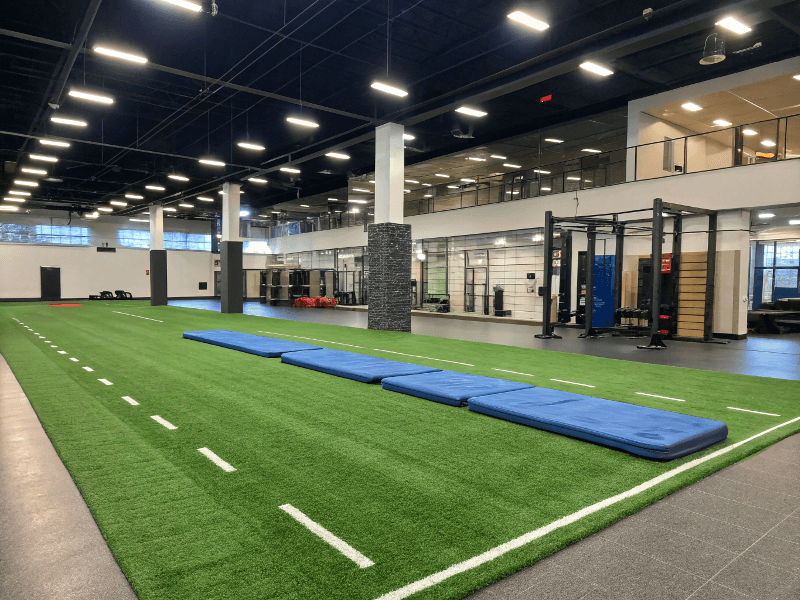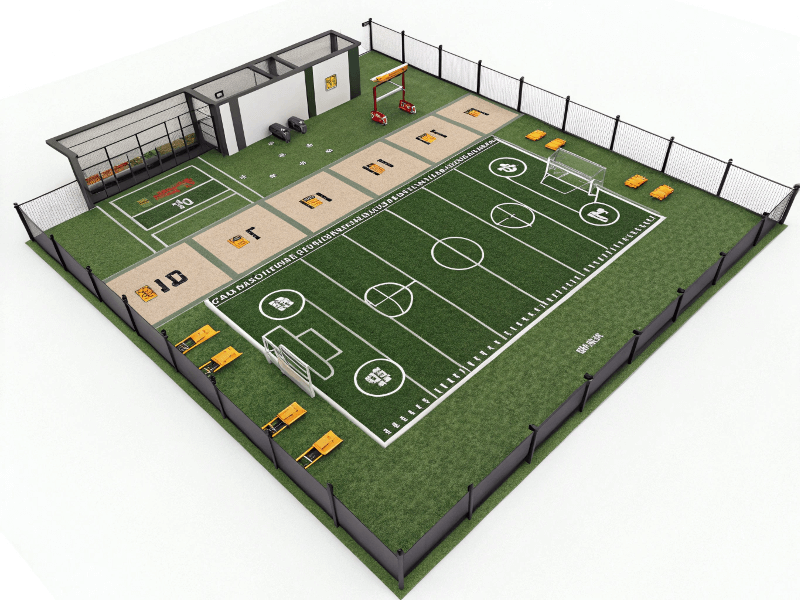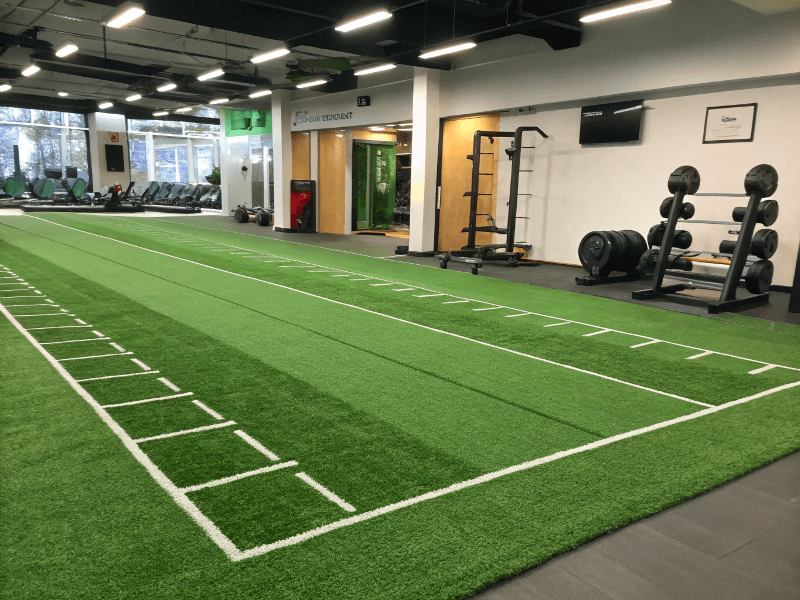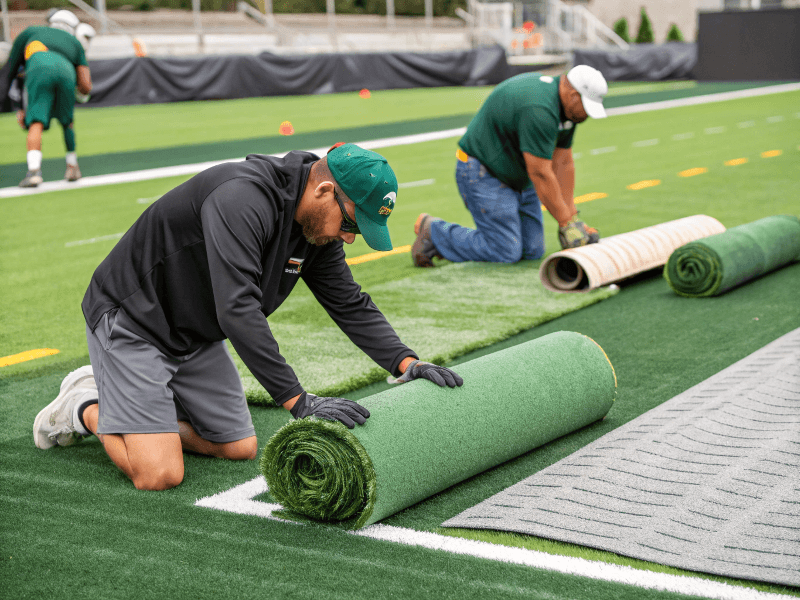Padded turf offers superior safety, performance, and durability for gyms and sports facilities through its integrated cushioning layer, typically 5mm PU foam backing, which provides impact absorption, reduces joint stress, and eliminates the need for rubber infill maintenance.
Modern fitness facilities demand flooring solutions that balance safety, performance, and practicality. After years of working with various gym owners and facility managers, I’ve witnessed firsthand how padded artificial turf has revolutionized indoor training environments. Unlike traditional infill systems that require constant maintenance and pose safety concerns, padded turf integrates a cushioning layer directly into the backing material.
The technology behind padded turf involves bonding a polyurethane foam layer, usually 5mm thick, to the grass fiber backing. This creates a unified surface that delivers consistent impact absorption without the complications of loose-fill materials. The PE fibers provide durability for high-traffic areas while maintaining their appearance over time.
What sets padded turf apart is its ability to provide immediate benefits upon installation. There’s no settling period, no infill redistribution issues, and no concerns about particle displacement during intense training sessions.

This integrated approach addresses the most common challenges I’ve encountered in facility management while opening new possibilities for training program design and space utilization.
How Does Padded Turf Enhance Safety in Training Environments?
The cushioning layer in padded turf reduces impact forces by up to 40% compared to hard surfaces, significantly lowering injury risk during falls, jumps, and high-intensity movements while providing consistent traction for various exercises.
Safety remains the primary concern for any facility manager, and padded turf addresses this through multiple mechanisms. The integrated foam backing creates a shock-absorbing surface that protects joints during plyometric exercises, sprints, and landing movements. I’ve seen athletes train more confidently knowing they have this protective layer beneath them.
Impact Absorption Technology
The 5mm PU foam layer compresses under load, distributing impact forces across a larger area. This reduces peak pressure points that typically cause joint stress and muscle fatigue. During sled pushes, battle rope exercises, and agility drills, this cushioning effect becomes particularly noticeable.
Slip Resistance and Stability
Unlike traditional gym flooring that can become slippery with moisture, padded turf maintains consistent traction. The grass fibers provide grip in multiple directions, supporting lateral movements, pivoting, and quick direction changes. This multi-directional traction reduces ankle injuries and provides confidence during explosive movements.
Edge Safety Design
Padded turf systems eliminate sharp edges and seams that can cause cuts or trips. The modular design allows for smooth transitions between sections, and the integrated backing prevents lifting or curling that creates hazardous conditions. This seamless installation reduces liability concerns and creates a professional appearance.

The combination of these safety features creates an environment where athletes can focus on performance rather than injury prevention, leading to more effective training sessions.
What Performance Benefits Does Padded Turf Provide for Different Training Types?
Padded turf optimizes athletic performance by providing appropriate energy return for explosive movements while offering enough cushioning for endurance activities, supporting everything from Olympic lifting to functional fitness classes.
Performance enhancement comes from the turf’s ability to provide the right balance of stability and cushioning for various training modalities. After installing padded turf in several high-performance facilities, I’ve observed improvements in training intensity and athlete confidence across different sports.
Multi-Modal Training Support
The surface accommodates powerlifting platforms, cardio equipment, and functional training areas within the same space. The cushioning doesn’t interfere with heavy lifting stability, yet provides enough give for plyometric exercises. This versatility eliminates the need for multiple flooring types in mixed-use facilities.
Energy Return Characteristics
Unlike overly soft surfaces that absorb too much energy, padded turf provides controlled energy return. During sprinting and jumping exercises, athletes maintain power transfer efficiency while still receiving joint protection. This balance is crucial for sport-specific training where power development is essential.
Equipment Compatibility
The surface supports various training equipment without damage concerns. Sleds, tires, and weighted implements can be used safely without tearing or wearing the surface. The durability of PE fibers ensures long-term performance under heavy equipment use.

This performance optimization extends to group fitness classes, where participants can transition between floor exercises, standing movements, and cardio activities without surface limitations affecting their workout quality.
How Does Padded Turf Compare to Traditional Flooring in Terms of Durability and Maintenance?
Padded turf requires 70% less maintenance than traditional gym flooring while lasting 8-12 years under heavy use, with no infill redistribution, seam separation, or specialized cleaning requirements.
Durability and maintenance considerations significantly impact facility operating costs and member satisfaction. My experience with various flooring types has shown padded turf to be superior in both areas, particularly for high-traffic commercial facilities.
Material Longevity
The PE fiber construction resists wear patterns common in high-traffic areas. Unlike rubber flooring that can tear or separate, or traditional infill turf that develops bare spots, padded turf maintains consistent appearance and performance. The integrated backing prevents delamination issues that plague bonded systems.
Maintenance Simplicity
Daily maintenance involves basic vacuuming or sweeping to remove debris. There’s no infill to redistribute, no specialized cleaning chemicals required, and no periodic deep cleaning needed. The antimicrobial properties of quality padded turf prevent odor development and bacterial growth.
Long-Term Cost Analysis
| Flooring Type | Biaya Awal | Pemeliharaan Tahunan | Replacement Cycle |
|---|---|---|---|
| Padded Turf | $$$ | $ | 8-12 tahun |
| Lantai Karet | $$ | $$$ | 5-7 years |
| Infill Turf | $$$ | $$$$ | 6-8 tahun |
| Hardwood | $$$$ | $$$$$ | 10-15 tahun |
The total cost of ownership favors padded turf due to reduced maintenance requirements and extended lifespan. Insurance considerations also improve due to enhanced safety characteristics.

This economic advantage becomes more pronounced in facilities with extended operating hours and high member usage, where maintenance costs can quickly accumulate with traditional flooring systems.
What Design Flexibility Does Padded Turf Offer for Facility Layout?
Padded turf’s modular design allows for custom layouts, color coding of training zones, and easy reconfiguration as facility needs change, with installation times 60% faster than traditional systems.
Design flexibility has become increasingly important as fitness facilities evolve to meet changing member preferences and training methodologies. Padded turf systems provide unprecedented flexibility in both initial design and future modifications.
Modular Installation Benefits
The tile-based system allows for precise fitting around equipment, columns, and irregular spaces. Installation doesn’t require specialized tools or extensive floor preparation, making it ideal for retrofit applications. I’ve completed installations in occupied facilities with minimal disruption to operations.
Color and Zone Designation
Different colored sections can designate specific training areas, creating visual organization and traffic flow management. Strength training zones, cardio areas, and functional fitness spaces can be clearly defined while maintaining surface consistency throughout the facility.
Reconfiguration Capabilities
As facility needs change, sections can be easily removed, relocated, or replaced. This adaptability protects the investment in flooring while allowing for program expansion or equipment changes. The ability to reconfigure layouts seasonally or for special events adds operational flexibility.

This design flexibility extends to temporary installations, making padded turf ideal for rental facilities, seasonal programs, and multi-use spaces that require quick transformation between different activities.
How Does Padded Turf Perform in Different Environmental Conditions?
Padded turf maintains consistent performance across temperature ranges from 32°F to 120°F, provides excellent moisture management, and contributes to improved indoor air quality with low VOC emissions.
Environmental adaptability is crucial for indoor facilities that experience temperature fluctuations, humidity changes, and air quality concerns. Padded turf systems demonstrate superior performance across these variables compared to traditional alternatives.
Temperature Stability
The PU foam backing maintains consistent cushioning properties regardless of temperature changes. Unlike rubber materials that can become hard in cold conditions or soft in heat, padded turf provides reliable performance year-round. This stability is particularly important in facilities without climate control or those with large door openings.
Manajemen Kelembaban
The backing material provides excellent drainage while preventing moisture penetration that can lead to mold or mildew issues. The synthetic fibers don’t retain moisture like natural materials, reducing humidity-related problems and maintaining a safe training surface even in high-humidity conditions.
Air Quality Considerations
Quality padded turf systems emit minimal volatile organic compounds, contributing to better indoor air quality. The absence of rubber particles eliminates concerns about airborne particles that can affect respiratory health during intense training sessions.

These environmental characteristics make padded turf suitable for facilities serving sensitive populations, including youth programs and rehabilitation centers where air quality and surface safety are paramount concerns.
What Are the Key Selection and Installation Considerations?
Successful padded turf installation requires selecting appropriate thickness (5-15mm), ensuring proper subfloor preparation, and working with certified installers to achieve optimal performance and warranty compliance.
Selection and installation decisions significantly impact long-term satisfaction and performance. My experience has shown that proper planning and execution are essential for maximizing the benefits of padded turf systems.
Thickness Selection Guidelines
For general fitness applications, 5-8mm thickness provides adequate cushioning while maintaining stability. High-impact activities may require 10-15mm thickness for optimal protection. The key is matching cushioning level to primary use patterns while considering equipment requirements.
Subfloor Requirements
The existing floor must be clean, level, and structurally sound. Minor imperfections can be addressed with appropriate underlayment, but major irregularities require correction before installation. Moisture barriers may be necessary in basement or ground-level installations.
Professional vs. DIY Installation
While some systems offer DIY installation options, professional installation ensures proper seaming, adhesive application, and warranty compliance. The time savings and quality assurance of professional installation typically justify the additional cost for commercial applications.

Working with experienced installers who understand the specific requirements of fitness facilities ensures optimal results and helps avoid common installation mistakes that can compromise performance and longevity.
Kesimpulan
Padded turf transforms gym and sports facilities through superior safety, performance optimization, and operational efficiency that traditional flooring cannot match.
Ready to experience the advantages of padded turf for your facility? Contact me today for a free consultation and sample kit. I’ll provide a detailed analysis of your space, customized recommendations, and a no-obligation quote that demonstrates the long-term value of this investment in your facility’s success.
